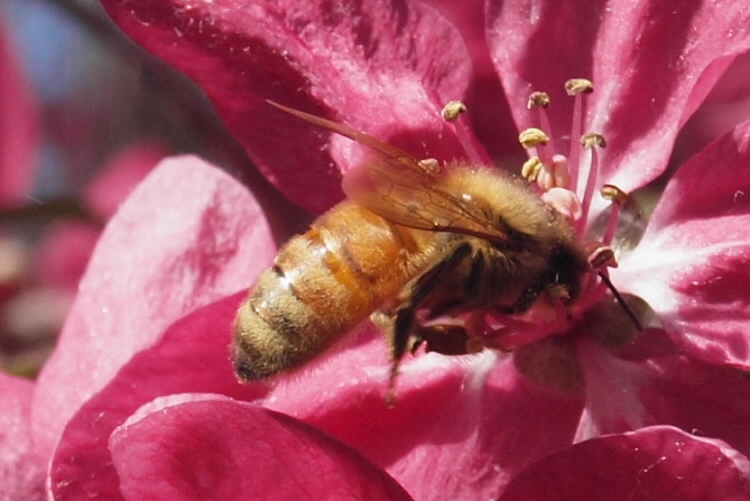Honey bees (Apis mellifera) are the most important pollinators of many cultivated food crops and other flowering plants. These plants would be in trouble without bees, and so would we.
Flowers need to be pollinated before they produce seeds and fruit, so without bee pollination, we’d have no apples, apricots, blueberries, nectarines, pumpkins, cherries, pears, cucumbers – the list goes on. All these crops were brought to New Zealand from around the world, but this country does not have these crops’ natural pollinators. Therefore, honey bees were introduced as well, and they have become the main pollinators of a very wide range of flowers.
As well as being essential for pollination, honey bees give us honey, wax, royal jelly and other products. Beekeepers look after honey bees by keeping the colonies in built hives, and they rent them out to crop growers to use for pollination in the flowering season.
The honey that honey bees make when they collect nectar from mānuka flowers has some special properties. Find out more in this article Honeybees and mānuka trees.
Honey bees at work
A hive can contain many thousands of bees, most of which are female workers. Each hive has a single queen that lays all the eggs and some male drones that mate with the queen to produce more workers.
When young, worker bees stay in the hive and do the housekeeping and build comb to hold the larvae (very young bees), which they also feed. When they’re a bit older, they become guards, defending the hive against invaders, including bees raiding from other hives. Finally, the workers become foragers, flying away from the hive to collect nectarpollen and water. When they return from a trip, they do a complicated dance that tells other foragers where to find food.
Honey bees get their food from flowers. Nectar contains energy-giving sugars and is collected to be eaten by adults and larvae. Any spare nectar is turned into honey and stored for later. Pollen is rich in proteinvitamins and minerals and is taken back to the hive to feed the larvae. Each bee tends to collect either nectar or pollen at any one time, but sometimes both.
It is while collecting nectar and pollen that the bees pollinate the flowers that provide the food. The bees crawl over and inside a flower to reach the nectar, and pollen from the flower’s anthers gets trapped on their hairy bodies. Pollen-gathering bees stop every now and then to push the pollen into little structures on their back legs called pollen baskets. When visiting another flower, some of the pollen on the body rubs off onto the stigma. If this flower is the same species as the flower the pollen came from, the pollen has got to the right place to complete pollination.
Plant & Food Research is investigating whether bumblebees can be used to pollinate flowers in commercial orchards. Find out more in this RNZ audio Bumblebees and pollination.
Plant & Food Research is also exploring the connection between maramataka and honey bee behaviour – offering insights for beekeepers.
Bees in trouble
There is a problem with honey bee populations at the moment that affects how well they pollinate crops and other flowering plants. A tiny mite called varroa was accidentally brought to New Zealand in about 2000. It lives on the outside of honey bees and spreads viruses that kill the bees. Colonies in beehives can only be kept alive by treating them twice a year with a chemical to kill the mites. Even then, the colonies are not as healthy or numerous as they used to be. Just as we depend on the bees to pollinate our crops, so the bees now rely on humans to keep them alive.
Recent research suggests that native insects may be more efficient at pollinating crops than originally thought.
Related content
Learn more about honey bees with the Connected journal articles in The Buzz of Bees.
Honey bees in New Zealand face a number of threats – learn about the work to detect and eliminate varroa mite and American foulbrood disease.
Activity ideas
Pass the pollen is a role-play activity in which students take on the role of flower parts and act out the process of insect pollination.
Pollinator counts – insects and flowers is a simple activity monitoring the pollinators in your area.
Useful links
Find out more about the New Zealand honey and beekeeping industry from Apiculture New Zealand.
Read about Colony collapse, climate change and public health in this article from George Washington University.
This blog article has more information about keeping bees.
Some more information on Making honey from flowers: a guide to bees.
Find out more about Aotearoa New Zealand's ngaro huruhuru – native bees on the for the love of bees website.



